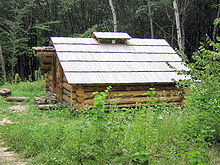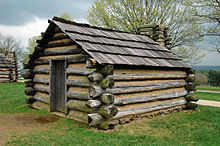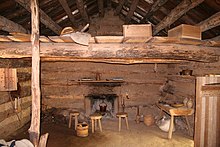Log cabin: Difference between revisions
→External links: added ref to "Old Oaken Bucket." to CLP link. |
|||
| Line 80: | Line 80: | ||
* [http://missourifolkloresociety.truman.edu/mocabins.html ''Log Cains of Missouri,'' from the [[Missouri Folklore Society]]] |
* [http://missourifolkloresociety.truman.edu/mocabins.html ''Log Cains of Missouri,'' from the [[Missouri Folklore Society]]] |
||
* [http://www.cabinquest.us ''CabinQuest.US'', A national directory of cabins, resorts and lodges.] |
* [http://www.cabinquest.us ''CabinQuest.US'', A national directory of cabins, resorts and lodges.] |
||
* Short radio episode [http://californialegacy.org/radio_anthology/scripts/walker.html <b>"Our Redwood Cabin,"</b>] poem by [[W.S. Walker]] from <i>[[Glimpses of Hungryland, or California Sketches]]</i>, 1880, from [[California Legacy Project]]. |
* Short radio episode [http://californialegacy.org/radio_anthology/scripts/walker.html <b>"Our Redwood Cabin,"</b>] poem (modeled on "[[Old_Oaken_Bucket#The_poem_.22The_Old_Oaken_Bucket.22|The Old Oaken Bucket]]") by [[W.S. Walker]] from <i>[[Glimpses of Hungryland, or California Sketches]]</i>, 1880, from [[California Legacy Project]]. |
||
[[Category:House types]] |
[[Category:House types]] |
||
Revision as of 15:55, 13 July 2009


A log cabin is a small house built from logs. It is a simple type of log house. A distinction should be drawn between the traditional meanings of "log cabin" and "log house." "Log cabin" generally denotes a simple one, or one-and-one-half story structure, somewhat impermanent, and less finished or less architecturally sophisticated. A "log cabin" was usually constructed with round rather than hewn, or hand-worked, logs, and often it was the first generation home building erected quickly for frontier shelter.[1]
European History of Log Cabins

Log cabins have a strong association with rustic and rural North America, but historically log construction has its roots in the timber-rich regions of Scandinavia and Eastern Europe. Although their origin is uncertain, the first log structures were probably built in Northern Europe in the Bronze Age (about 3500 BC). By the time Europeans began to settle in America, there was a long tradition of using logs for houses, barns, and other outbuildings in the Scandinavian countries, Germany, Northern Russia[2] and Ukraine[3]
By stacking tree trunks one on top of another and overlapping the logs at the corners, the "log cabin" was born. Interlocking corners were soon developed by notching the logs at the ends, resulting in strong structures which were also easier to make weather-tight by inserting moss or other soft material into the joints. As the original coniferous forest extended over the coldest parts of the world there was a prime need to keep these houses warm, and the insulating properties of the solid wood were a great advantage over a timber frame construction merely covered with animal skins, felt, boards or shingles. Over the centuries increasingly complex joints were developed to ensure more weather tight joints between the logs but these profiles were still largely based on the round log.
In the Wood Museum in Trondheim, Norway, fourteen different traditional profiles are shown, but a basic form of log construction was used all over North Europe and Asia. These methods of log building were transferred to North America with the early settlers, where it became a popular form of construction for the pioneers settling in the far north and the more mountainous parts of America and Canada where winter conditions were often extreme.[4]

In the United States, log cabins were first constructed beginning in 1638. Log structures were used by Swedish settlers in New Sweden in what is now Wilmington, Delaware. Later German and Ukrainian immigrants also used this technique. The Scots and Scots-Irish had no tradition of building with logs, but they quickly adopted the method. Log cabins were not widely used by the first English settlers.[1] Few log cabins dating from the 18th century still stand, but they were not intended as permanent dwellings. When a larger, more formal house was constructed, log cabins were often converted into outbuildings for chicken coops, animal shelters, or other utilitarian purposes.
When cabins were built with the intention of applying siding, the logs were usually hewed on the outside to facilitate the application of the siding. When logs were hewed on the inside as well, they were often covered with a variety of materials, ranging from plaster over lath to wallpaper.
Traditional log buildings in North America
Log cabins were built from logs laid horizontally and interlocked on the ends with notches (British English cog joints). Some log cabins were built without notches and simply nailed together, but this was not as structurally sound. Modern building methods allow this shortcut.

The most important aspect of cabin building is the site upon which the cabin was built. Site selection was aimed at providing the cabin inhabitants with both sunlight and drainage to make them better able to cope with the rigors of frontier life. Proper site selection also placed the home in a location best suited to manage the farm or ranch. When the first pioneers built cabins, they were able to "cherry pick" the best logs for cabins. These would be old growth trees with few limbs (knots) and be straight with little taper. Logs of this type did not need to be hewed to fit well together. Careful notching minimized the size of the gap between the logs and reduced the amount of chinking (sticks or rocks) or daubing (mud) needed to fill the gap. The length of one log was generally the length of one wall, although this was not a limitation for most good cabin builders.
Decisions had to be made about the type of cabin. Styles varied greatly from one part of the US to another: the size of the cabin, the number of stories, type of roof, the orientation of doors and windows all needed to be taken into account when the cabin design was being made. In addition, the source of the logs, the source of stone and the available labor either human or animal had to be considered. If timber sources were further away from the site, the cabin size might be limited.
Cabin corners were often set on large rocks; if the cabin was large, other stones were used at other points along the sill (bottom log). Thresholds, since they were usually cut into the sill, were supported with rock as well. These stones are found below the corners of many 19th century cabins as they are restored. Cabins were set on foundations to keep them out of damp soil but also to allow for storage or cellars to be constructed below the cabin. Cabins with earth floors had no need for foundations.

Cabins were constructed using a variety of notches. Notches can vary within ethnic groups as well as between them. Notches often varied on a single building, so their styles were not conclusive.
Roofing
Log cabins were constructed with either a purlin roof structure or a rafter roof structure. A purlin roof consists of horizontal logs that are notched into the gable-wall logs. The latter are progressively shortened to form the characteristic triangular gable end. The steepness of the roof was determined by the reduction in size of each gable-wall log as well as the total number of gable-wall logs. Flatter roofed cabins might have had only 2 or 3 gable-wall logs while steeply pitched roofs might have had as many gable-wall logs as a full story. Issues related to eave overhang and a porch also influenced the layout of the cabin.
The decision about roof type often was based on the material for roofing. Milled lumber was usually the most popular choice for rafter roofs in the areas where it was available. These roofs typify many log cabins built in the 20th century, having full-cut 2x4 rafters covered with skip sheeting and cedar shingles. The purlin roofs found in rural settings and locations, where milled lumber was not available, often were covered with long hand-split shingles.
Some older buildings in the American Midwest and the Canadian Prairies are actually log structures covered with clapboards or other materials. Nineteenth-century cabins used as dwellings were occasionally first plastered on the interior. The O'Farrell Cabin (ca. 1865) in Boise, Idaho had backed wallpaper used over newspaper. The C.C.A. Christenson Cabin in Ephraim, Utah (ca. 1880) was plastered over willow lath.

Log cabins reached their peak of complexity and elaboration with the Adirondack-style cabins of the mid-18th century. These formed the basis for many United States Park Service lodges built at the end of the 19th century and beginning of the 20th century. Log cabin building never died out or fell out of favor. It was surpassed by the needs of a growing urban America. During the 1930s and the Great Depression, the Roosevelt Administration directed the Civilian Conservation Corps to build log cabins throughout the west for use by the Forest Service and the National Park Service. Timberline Lodge on Mount Hood in Oregon was such a log structure, and it was dedicated by President Franklin D. Roosevelt.
In 1930, the world's largest log cabin was constructed at a private resort in Montebello, Quebec, Canada. Often described as a "log château", it serves as the Château Montebello hotel.

The modern version of a log cabin is the log home, which is a house built usually from milled logs. The logs are visible on the exterior and sometimes interior of the house. These cabins are mass manufactured, traditionally in Scandinavian countries and increasingly in Eastern Europe, using squared milled logs that are precut for easy assembly. Log homes are popular in rural areas, and even in some suburban locations. In many resort communities in the American West, homes of log and stone measuring over 3,000 sq ft (280 m2) are not uncommon. These "kit" log homes are one of the largest consumers of logs in the Western United States.
In Europe, modern log cabins are often built in gardens and used as summerhouses, home offices or as an additional room in the garden. Summer houses and cottages are often built from logs in northern Europe.
Chinking refers to the mortar/infill material between the logs in the construction of log cabins and other log-walled structures. Traditionally, dried Pleurozium schreberi or Hylocomium splendens were used in the Nordic countries as an insulator between logs.
Symbolism

The log cabin has been a symbol of humble origins in American politics since the early 19th century. Seven United States Presidents were born in log cabins, including Abraham Lincoln, Andrew Jackson, and James Buchanan.[5] Although William Henry Harrison was not one of them, he and the Whigs during the 1840 presidential election were the first to use a log cabin as a symbol to show Americans that he was a man of the people. Other candidates followed Harrison's example, making the idea of a log cabin—and, more generally, a non-wealthy background—a recurring theme in campaign biographies.[6]
More than a century after Harrison, Adlai Stevenson acknowledged: "I wasn’t born in a log cabin. I didn’t work my way through school nor did I rise from rags to riches, and there’s no use trying to pretend I did."[6] Stevenson lost the 1952 presidential election in a landslide to Dwight D. Eisenhower.
Toys
A popular children's toy is Lincoln Logs, consisting of various notched dowel rods that can be fitted together to build scale miniature-sized structures. Lincoln Logs are said to have been named after Abraham Lincoln, who was born in a log cabin in rural Kentucky. He grew up in another log cabin in Illinois.
Notes
- ^ a b Bomberger D., "The Preservation and Repair of Historic Log Buildings", National Park Service, 1991, accessed 6 Dec 2008
- ^ Log Cabins in America:The Finnish Experience, National Park Service Teaching with Historic Places Lesson Plan, accessed 2 Jul 2008
- ^ Wishart, D. Encyclopedia of the Great Plains, University of Nebraska Press, 2004 ISBN 0803247877
- ^ Thépaut R. Round timber in construction: An introduction Report prepared for the UK Forestry Commission, TRADA Technology Ltd 2003
- ^ "President's Park (White House)", National Park Service, accessed 2 Jul 2008
- ^ a b Lepore, Jill. "BOUND FOR GLORY: Writing campaign lives", The New Yorker, 20 October 2008.
Further reading
- Weslager, C. A. The Log Cabin in America (New Brunswick, New Jersey: Rutgers University Press. 1969)
- McRaven, Charles. Building and Restoring the Hewn Log House (Betterway Books. 1994)
- Gudmundson, Wayne. Testaments in Wood ( Minnesota Historical Society Press. 1991)
- Fickes, Clyde P. and W. Ellis Groben. Building with Logs & Log Cabin Construction (Algrove Publishing. 2005))
- Phleps, Hermann. The Craft of Log Building (Roger Macgregor, translator. HarperCollins; Repr edition. 1989)
- Aldrich, Chilson D. The Real Log Cabin (MacMillan. 1946)
- Holan, Jerri. Norwegian Wood (Rizzoli; First American Edition edition. 1990)
See also
External links
- Log Cabins in America:The Finnish Experience, National Park Service Teaching with Historic Places Lesson Plan
- Log Cains of Missouri, from the Missouri Folklore Society
- CabinQuest.US, A national directory of cabins, resorts and lodges.
- Short radio episode "Our Redwood Cabin," poem (modeled on "The Old Oaken Bucket") by W.S. Walker from Glimpses of Hungryland, or California Sketches, 1880, from California Legacy Project.
